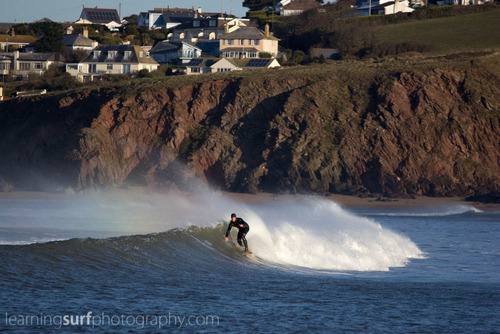Any post which has Todays Lesson in the title is based on something I have learned on my most recent shoot, I am still learning a lot about photography, I even discover basic stuff that I probably should have picked up ages ago on a regular basis.
Last time it was about setting the autofocus mode correctly before putting the camera in the housing, this time it’s about selecting the right focus point.
Examples

This shot of Ben Howey was taken from the rocks on the East end of Bantham beach, I used my 70-200mm lens and had the centre autofocus point active.
I also had the camera set up in Back Button Focus mode, this means that half pressing the shutter does not activate autofocus, instead you press the AF-ON button on the back. There’s a link at the bottom to a page on the Canon USA page that explains why this is useful, this is perhaps the most important reason for us as surf photographers:
Less risk of focus errors with moving subjects
For sports photographers and others taking action pictures, back-button AF lets you stop focus whenever something might interfere with the moving subject you’re tracking — without requiring you to stop shooting. In sports, for instance, it’s common for a referee or another player to come between the camera and an athlete being photographed. With back-button AF, it’s easy to momentarily pull your thumb off the rear button, and you can still keep shooting by pressing the shutter button fully. The camera instantly stops focusing when your thumb comes off the back button. Once the obstruction is out of your way, you can immediately pick-up your primary subject by pressing your thumb on the back button again.
The photo is in focus, the exposure is OK and it’s pretty crisp, I shot in Shutter priority at 1/1000 of a second, the sun was up so the camera managed f5 at an ISO of 100.
The issue is with the composition, the interesting thing about this angle is the background, sometimes it’s Burgh Island and the hotel, in this case I wanted a more side-on view to differentiate it a bit from every other shot of Bantham from this end of the beach so it’s the cliff and houses at Bigbury.
What definitely isn’t interesting is the flat water in the foreground, so I want less of the water and more of the cliff in the frame, but I still need the subject in focus and with the subject moving towards me pretty rapidly I can’t just focus and then recompose, I need to focus on the surfer whilst I compose for the most interesting shot.

This example features Ben Fisher a little further inside, with a much more interesting composition, all I had to do was move the autofocus point to the bottom to achieve this, it could have looked better if I had selected the bottom left focus point but I might have lost the rainbow in the spray, next time I’m going to experiment more.
Here’s a video on Youtube which talks you through selecting different Autofocus points on the 60D, the process is very similar for all DSLR’s
I have some more photo’s that I prefer, I’m going to put a bunch up in an album on the learning surf photography Facebook page, which will include shots from the water at dawn which were all shot with the 70-200mm lens in a cheap Aquapac DSLR case.
Resources and Links
- The full photo album with lots more examples on the learning surf photography facebook page.
- Canon autofocus guide (this is a pdf) – Canon’s own guide to autofocus settings, well worth a read even if you don’;t shoot with a Canon EOS body.
- Full article on Back Button Focus
Leave a Reply